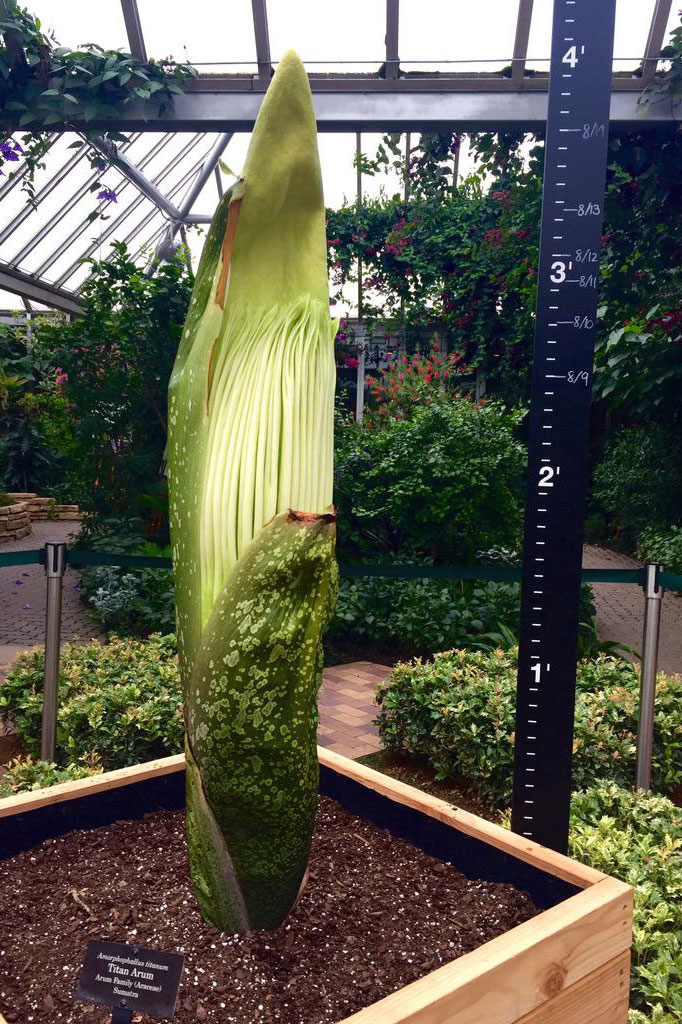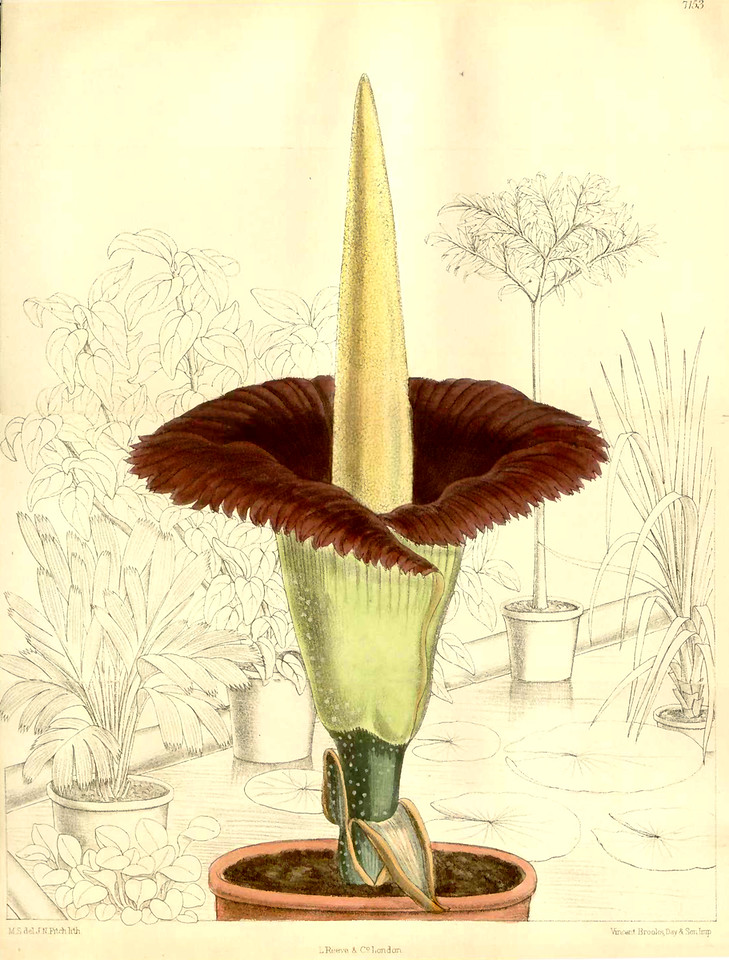
Some day very soon, a corpse flower will bloom in Glencoe, twelve years after it arrived at the Chicago Botanic Garden. It will release an intense odor of carrion, hence the name. There are multiple species referred to as a "corpse flower"; this one is the titan arum, a name bestowed upon it by Sir David Attenborough, bowdlerizing its Latin name, Amorphophallus titanum. Which means exactly what you think it means.
And when it reveals itself and begins to smell of death, the Chicago Botanic Garden will stay open until 2 a.m., because the titan arum blooms at night—because of course—and if history is any guide, lots of people will want to see it, because it's an event: a giant plant that takes over a decade to bloom, and then only for a day or so.
According to Julie McCaffrey, the media manager for the Botanic Garden, the flower, dubbed Spike, is expected to bloom in the next four to seven days, so probably in the middle of next week. The Garden is comparing its flower to a similar one in Denver, which is expected to bloom on Sunday. Spike is still ten inches shorter than its Denver sibling.
The event has been a long time coming—since 2003, in fact. Tim Pollak, the outdoor floriculturalist at the Botanic Garden, started there in 2001, and the titan arum arrived two years later. The team planted six seedlings in 2003, which take several years to sprout anything. Three more were added in 2005. By 2015—the 12 year mark—the team anticipated a flower to bloom instead of just leaves, though the exact 'when' was up in the air.
"For 12 years, we got a leaf," Pollak says. "When the corm [the underground plant stem] gets up to size, you start thinking, maybe the next time it'll send up a flower… maybe next time."
Then it starts to look a bit different.
"I go back to grower's intuition as far as the appearance of a shoot compared to what a leaf shoot had typically been looking like," Pollak says "Then we're looking at the overall size and shape of the shoot—flowers tend to be typically more bulging and swollen at the base of the shoot than a leaf would be. The other part would be, looking from the top, right straight down at it, if that shoot looks a little bit off-center or asymmetrical, that's a really good sign that you have a flower. That was one of our big clues last week, on August 3, that really said to us, we have a flower here.
"What we needed to do is get a little more confirmation; being first time parents, if you will, of a flower, just to make sure, before we could go public. We sent out some pictures and descriptions to various colleagues at other botanic gardens that have had success blooming a titan arum. And it came back that, yeah, that looks like a flower."
When I spoke to Pollak on Wednesday, the titan arum's rapid growth—it's been adding four to six inches per day—had slowed down, a sign of it getting closer to bloom. Its flowers develop (the titan arum is an inflorescense, a cluster of flowers), and it gets hot, around 90 degrees. It's also gotten to be around 25" in girth—once again earning its Latin name.
And all of this together—its height, its heat, and its rapid growth—goes a long way towards explaining why the titan arum takes so long to bloom and why the bloom is so brief. It's a lot of energy to expend, at least for a plant, but the process works together. The heat essentially vaporizes and disperses the chemicals that cause its smell, like a plug-in air freshener that smells like rotting flesh. (Or "limburger cheese, garlic, rotting fish, and smelly feet," or "rotting fish mixed with burnt sugar.")

Those chemicals seem to be dispersed even further by how that heat is distributed within the plant. The giant spadix—that fleshy spike with little flowers on it—at the center actually pulses out heat—up to 96.8 degrees—and the odor emissions are synced with those pulses. As the authors put it, it's a "convective flower."
When the beetles and flies that pollinate the titan arum get a whiff of its flesh, they're drawn into a blood-red spathe… which happens to be warm.
Those insects happen to be more active at night, coinciding with the titan arum's bloom. But it's not the only adaptation of its timing. "In a rainforest, you get a lot of daytime and evening rains that can do some destruction," Pollak says. "Plus, on a hot, sunny day, the spathe can be damaged; that's why it's opening up more at night; it's an adaptation that's allowed the flowers to be protected."
[It's worth noting that Spike will not be pollinated this way. Since it's in a greenhouse and no flies or beetles are around, the team will hand-pollinate the plant.]
It's a curious but logical evolution for a plant pollinated by flies and beetles. From the perspective of a person, it's a phallus ringed by a petal the color of blood and smelling like a smorgasboard of all the worst things, and a challenge to grow—yet it's beloved by botanists and laymen alike, a genuine event in the botanical world. After all, it takes about as long to come to physical maturity as a human.
"We're keeping our fingers crossed, making sure that the temperatures are okay at night," Pollak says. "As we get closer, we're starting to be those protective parents a little bit more."


